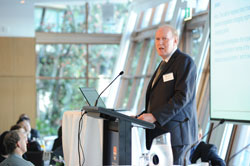Opinion Pieces: since 2007, Prof. David Hensher has written an opinion column in the Australasian Bus and Coach magazine, where he monthly discusses a lot of different transport-related hot topics. In this section we are revisiting these columns.
December 2012
The call for a congestion charge is getting louder and more frequent in many countries as major metropolitan areas experience increasing levels of road congestion. This is often accompanied by a recognition that governments need to find new sources of revenue to maintain existing road networks and to invest in new transport infrastructure. Although reform of road pricing is almost certain to occur at some time in the future, a key challenge is in selling the idea to the community of road users as well as a whole raft of interest groups that influence the views of society and politicians. Simply announcing a need for a congestion charge (often misleadingly called a tax) does little to progress the reform agenda. What is required is a carefully structured demonstration of what might be done to progressively introduce adjustments in road user charges that are seen as reducing the costs to motorists while ensuring no loss of revenue to government. My colleagues (Profs Bliemer and Mulley) and I suggest that this can be achieved by the reform of registration fees in the presence of a distance-based charging regime, that can deliver financial gains to motorists with prospects of revenue growth to the State Treasury of Sydney. Such a reform package is predicted to result in changes to total annual kilometres of travel (especially in the peak) and flow through gains in travel time that deliver reductions in traffic congestion, typically 4.7 percent reduction in peak kilometres in Sydney. We see this as an essential first stage in gaining community support for road pricing reform – proof of cost reductions associated with improvements in traffic congestion can then be used to continue the reform process.
This road pricing reform plan would require drivers to purchase an on-board unit (OBU) (approximately $50 once off cost) that will record the kilometres by time of day. The off peak kilometres are not charged, but peak kilometres will be charged at the agreed cents/km. This scenario implies that if an OBU is not installed, all kilometres will be charged as peak kilometres, giving an incentive to install a meter (with the expectation that all motorists will do so), just like households have had with off peak electricity meters or with water meters when they were first introduced.
To establish the financial implications of alternative combinations of a peak period distance-based charge (DBC) and discounted annual registration fees, we have built a scenario decision support system (in excel). The key inputs, for each statistical sub division in Sydney (SSD) and status quo (i.e., before) situation, are the mean annual kilometres, the proportion of kilometres in the peak periods (AM and PM), the average daily cost per driver (comprising fuel and tolls, distinguished by peak and off peak periods), annual registration fees, and mean direct elasticities of peak and off peak kilometres with respect to usage costs. In addition, for the reform scenarios, we considered a DBC varying from 2c/km to 10c/km in the peak, and allowed annual registration fees to vary from 30 to 75 percent of the status quo annual fee.
The decision support system calculates the status quo total costs and kilometres for all drivers and revenue to State Treasury, distinguishing outlays and receipts for the peak and off peak periods. We then introduce the range of peak-period DBCs and discounted registration fees and calculate the combination of these two cost outlays for motorists of each SSD that results in both a reduced mean cost outlay to motorists and no loss in revenue to State Treasury. At the SSD level, we expect to obtain different DBC levels for a given discount on the registration fee, and indeed that is what was obtained. The range is three to eight cents/km. Taking the lowest value would ensure net gains to each SSD motorist, but would result in the loss of neutrality (or better) to Treasury revenue. Placing different charges on motorists over the metropolitan area would raise clear concerns from many perspectives including the political ramifications.
A preferred solution is to take a system wide approach, and to identify a single DBC, given a discounted registration fee, that achieves the required financial outcomes for drivers and State Treasury. The selected peak period DBC is 5c/km with a discounted registration fee of $185, slightly greater than a 50 percent reduction. On average, a driver saves $9 per annum and Treasury gains $32 per driver per annum. These are extremely low amounts per driver, but they translate into sizeable financial gains to all drivers and State Treasury.
Food for thought
¿Comments? ¿Opinions? ¿Similar News? Send them to us!













